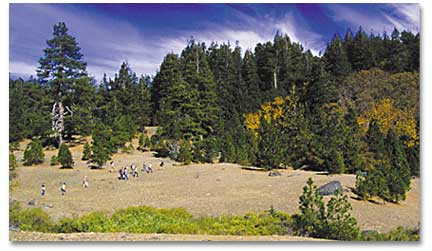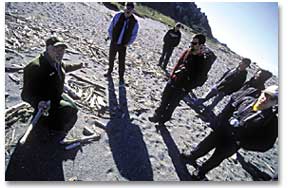|

COVER STORY | IN THE NEWS | OFF THE PAVEMENT | ARTBEAT
TALK OF THE TABLE | THE HUM | CALENDAR
November 9, 2006

Outdoor Classroom

story & photos by BENNETT BARTHELEMY
"Come forth into the light of things.
Let nature be your teacher."
-- WILLIAM WORDSWORTH
When I dredge out the murky
lessons of my state-sanctioned education, what are most clear
are ones learned far from the four walls of a classroom. In fact,
many of the outdoor lessons are crystalline -- like my sixth-grade
trip to the mountains above Santa Barbara. From the view of a
quarter century (and after a BA in Native American studies),
I can comfortably say there is nothing better than learning about
California native history in an oak grove, in warm dappled sunlight
and in a spot that had actually been used to gather and process
acorns; to see the mortar holes left in soft sandstone. It is
far easier to imagine the gritty taste of the food and molars
wearing out prematurely when rooted in the reality of location,
where you can bear witness to physical evidence.
Today it amazes me how those outdoor lessons have
stuck. My guess is that the learning was disguised, like a pill
given to a dog in a piece of bread. Easy to choke down and good
for you, too, in ways that I could not fathom then. So when I
got my first teaching assignment -- Native American history at
CR -- I sent the students outside to do research and experience
first-hand the incredible opportunities to gain perspective right
in their backyards. Humboldt is rich with native history and
vibrant native culture that many students were oblivious to;
it would be criminal to teach a class and not give students the
opportunity to explore what surrounds us here on the North Coast.
 Last weekend I was
fortunate enough to tag along with my wife on her plant taxonomy
field trip to Horse Mountain. The sciences are great -- they
encourage you (and later pay you) to get out there and have crazy
adventures. Serpentine soils hold high concentrations of certain
minerals and drain quickly, which require trees with hearty dispositions,
like white pine. I never would have remembered that if I
read it in a book! There is adventure in being on location for
learning, and even the best multi-media presentation can't match
it. So, thank you to all the teachers that are daring enough
to get students outside and provide extra little tap over the
edge of wonder. Last weekend I was
fortunate enough to tag along with my wife on her plant taxonomy
field trip to Horse Mountain. The sciences are great -- they
encourage you (and later pay you) to get out there and have crazy
adventures. Serpentine soils hold high concentrations of certain
minerals and drain quickly, which require trees with hearty dispositions,
like white pine. I never would have remembered that if I
read it in a book! There is adventure in being on location for
learning, and even the best multi-media presentation can't match
it. So, thank you to all the teachers that are daring enough
to get students outside and provide extra little tap over the
edge of wonder.
So what happens when you have maxed out the allowable
units and financial aid has cut you off? Then the real fun of
learning begins. How many times have you rushed past the interpretive
signs to get down to the beach? Now is your big chance to glean
a quick and dirty geology or botany lesson with the escarpment
or trillium staring you in the face. These face-to-face moments
mean that long-term retention hovers around a whopping 70 percent,
rather than the 15 percent found in the average classroom. Think
how smart you will be, and in so little time, and without spending
all the money on textbooks that will no doubt become obsolete
next semester anyway.
The Ah-Pa interpretive trail at Prairie Creek Redwoods
is just one example. For those that clue into the existence of
interpretive signs, or numbered posts with a pamphlet, they find
them secretly lurking all over -- like telephone poles that become
part of the landscape. It's amazing the amount of back and forth
haggling that goes into one of these signs when it deals with
something human -- if you have ever been to a cultural committee
meeting of a local tribe when park officials are there trying
to hash out the proper language, what images to use, where to
put them, it is truly impressive that any ever get pounded in.
However, this assures that you are getting good, solid, appropriate
info that you would be paying a lot of money for in a university.
One of the best days I have had was out with interpretive
ranger Jim Wheeler in Prairie Creek Redwoods State Park on a
guided tour. A distillation of some two decades of knowledge
crammed into a few hours on the trails. Tales of old-growth wood
robbers and poachers, the history of the local environmental
movement and what it has meant to the local parks, identifying
obscure plants, learning about eco-systems and native history
-- I would have had to take two semesters worth of science and
anthropology classes to get all that he shared!
Take Alexander von Humboldt. Did he get so smart
and become the Renaissance man he was because he hung out at
the university? No way. He climbed peaks, paddled rivers, backpacked
and brought with him an incredible thirst for adventure and first-hand
knowledge that propelled him to be one of the most impressive
naturalists of all time.
So my advice for higher education is to go the
park and read the signs and talk to the rangers. Hard to beat
the quality of the education and it will certainly be cheaper.
Then, invest in hiking boots, kayak and climbing gear and notebook,
and the learning will come naturally, without all the stress
of GRE scores and mountains of loan debt. If you have unmotivated
or recalcitrant kids, send them on a month-long Outward Bound
course and save the hassle of expensive private schools. They
will thank you in 10 years. Or do what I wish had done and take
a semester-long National Outdoor Leadership School (NOLS) course
somewhere exotic like Alaska or Baja -- or, even better, sign
on for a Sierra Wilderness Institute seminar. (You can get college
credit for both!)
My humble opinion is that you can and should be
in charge of your own education. Too many of us have moldered
away the hours in a stale, static, controlled environment, chained
to the ivory tower of state-sanctioned education in a classroom.
Request that the teacher unlock the door. If even for just a
few hours here and there, exchange the ivory tower for a grove
of towering redwoods, and your chains won't cut so deeply. Hell,
they may not even leave permanent scars.
Enjoy your wanderings and adventures. Relax and
know that you are being educated just by being outside! Just
don't forget to ask a few questions.
  
Email Bennett Barthelemy at [email protected],
or write in care of the Journal at 145 G St., Suite A, Arcata,
95521.
COVER STORY | IN THE NEWS | OFF THE PAVEMENT | ARTBEAT
TALK OF THE TABLE | THE HUM | CALENDAR
Comments? Write a letter!

© Copyright 2006, North Coast Journal, Inc.
|